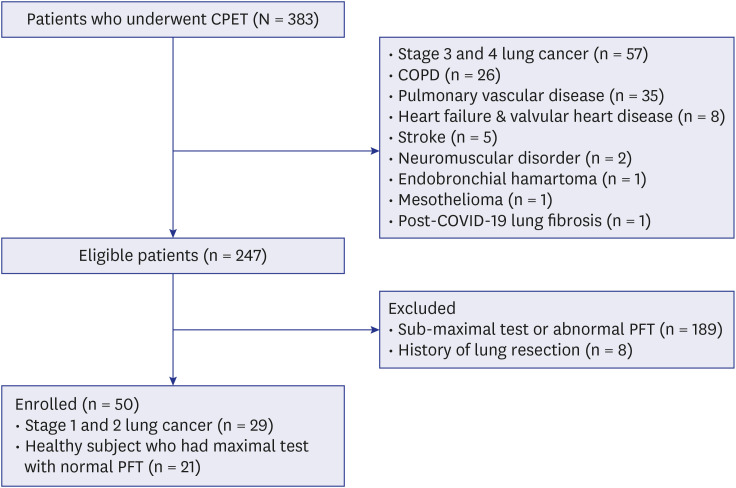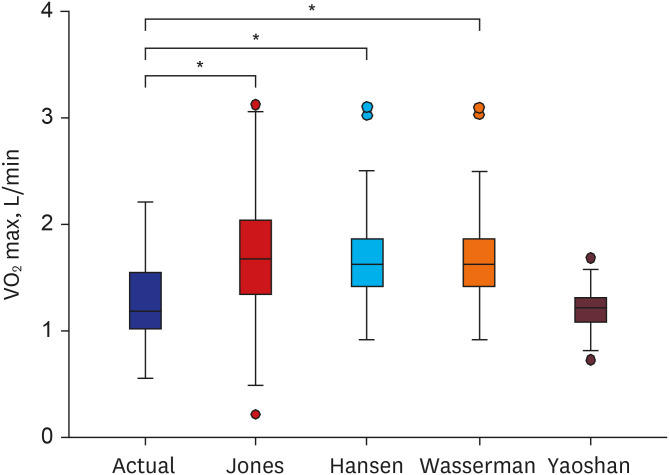J Korean Med Sci.
2022 Apr;37(14):e113. 10.3346/jkms.2022.37.e113.
Comparison of Predicted Exercise Capacity Equations in Adult Korean Subjects
- Affiliations
-
- 1Division of Pulmonology and Critical Care Medicine, Department of Internal Medicine, Asan Medical Center, University of Ulsan College of Medicine, Seoul, Korea
- KMID: 2528143
- DOI: http://doi.org/10.3346/jkms.2022.37.e113
Abstract
- Background
Maximal oxygen uptake (VO2 max) is a useful index to assess exercise capacity. However, there is no reference value for Koreans. This study aimed to compare actual VO2 max and predicted VO 2 max using exercise capacity equations in Korean subjects.
Methods
This retrospective study enrolled 383 patients who underwent cardiopulmonary exercise test (CPET) with incremental maximal cycle ergometer test at Asan Medical Center from January 2020 to May 2021. Stage 1 and 2 lung cancer patients with normal lung function and healthy persons of 50 subjects who had maximal CPET were analyzed.
Results
The subjects were aged 65 ± 13 years and predominantly male (74%). CPET results were as follows: absolute VO2 max, 1.2 ± 0.3 L/min; body weight referenced VO2 max, 20 ± 3.9 mL/kg/min; peak work rate, 94 ± 24 watts; peak heart rate, 142 ± 21 bpm; peak O 2 pulse, 10 ± 3 mL/beat; minute ventilation, 59 ± 14 L/min; peak respiratory rate, 34 ± 6 breaths per minute; and peak breathing reserve, 41 ± 18%. There was significant discordance between the measured and predicted absolute VO2 max using the Jones, Hansen, and Wasserman prediction equations developed for Caucasian population (P < 0.001). Agreement using Bland-Altman test between true and predicted absolute VO2 max was the best in Chinese equation (−0.03, 2SD = 0.55) compared to Jones (0.42, 2SD = 1.07), Hansen (0.44, 2SD = 0.86), and Wasserman (0.42, 2SD = 0.86) equations.
Conclusion
The reference value and prediction equation from studies including primarily Caucasians may not be appropriate for Koreans. Since the mean difference is the lowest in Chinese equation, the Chinese equation might be used for the Korean adult population.
Figure
Cited by 1 articles
-
Korean vs. Western Exercise Capacity Nomograms for Korean Patients With Cardiovascular Disease
Soohyung Park, Byambakhand Battumur, Seo Yeon Yoon, Yohan Lee, Se hyun Park, Kyuho Lee, Seungmin Back, Jieun Lee, Dong Oh Kang, Jah Yeon Choi, Seung-Young Roh, Jin Oh Na, Cheol Ung Choi, Jin Won Kim, Seung-Woon Rha, Chang Gyu Park, Eung Ju Kim
J Korean Med Sci. 2023;38(23):e179. doi: 10.3346/jkms.2023.38.e179.
Reference
-
1. Laveneziana P, Di Paolo M, Palange P. The clinical value of cardiopulmonary exercise testing in the modern era. Eur Respir Rev. 2021; 30(159):200187. PMID: 33408087.
Article2. Myers J, Prakash M, Froelicher V, Do D, Partington S, Atwood JE. Exercise capacity and mortality among men referred for exercise testing. N Engl J Med. 2002; 346(11):793–801. PMID: 11893790.
Article3. Palange P, Ward SA, Carlsen KH, Casaburi R, Gallagher CG, Gosselink R, et al. Recommendations on the use of exercise testing in clinical practice. Eur Respir J. 2007; 29(1):185–209. PMID: 17197484.
Article4. Kim HJ, Park SW, Cho BR, Hong SH, Park PW, Hong KP. The role of cardiopulmonary exercise test in mitral and aortic regurgitation: it can predict post-operative results. Korean J Intern Med. 2003; 18(1):35–39. PMID: 12760266.
Article5. Hwang TW, Kim SO, Kim MS, Jang SI, Kim SH, Lee SY, et al. Short-term change of exercise capacity in patients with pulmonary valve replacement after tetralogy of fallot repair. Korean Circ J. 2017; 47(2):254–262. PMID: 28382082.
Article6. Kim GB, Kwon BS, Choi EY, Bae EJ, Noh CI, Yun YS, et al. Usefulness of the cardiopulmonary exercise test in congenital heart disease. Korean Circ J. 2007; 37(10):489–496.
Article7. Kim JY, Yun BS, Lee S, Jung SY, Choi JY, Kim NK. Changes in strain pattern and exercise capacity after transcatheter closure of atrial septal defects. Korean Circ J. 2017; 47(2):245–253. PMID: 28382081.
Article8. American Thoracic Society. American College of Chest Physicians. ATS/ACCP Statement on cardiopulmonary exercise testing. Am J Respir Crit Care Med. 2003; 167(2):211–277. PMID: 12524257.9. Paap D, Takken T. Reference values for cardiopulmonary exercise testing in healthy adults: a systematic review. Expert Rev Cardiovasc Ther. 2014; 12(12):1439–1453. PMID: 25418758.
Article10. Jones NL, Makrides L, Hitchcock C, Chypchar T, McCartney N. Normal standards for an incremental progressive cycle ergometer test. Am Rev Respir Dis. 1985; 131(5):700–708. PMID: 3923878.11. Hansen JE, Sue DY, Wasserman K. Predicted values for clinical exercise testing. Am Rev Respir Dis. 1984; 129(2 Pt 2):S49–S55. PMID: 6421218.12. Wasserman K. Principles of Exercise Testing and Interpretation: Including Pathophysiology and Clinical Applications. 5th ed. Philadelphia, PA, USA: Wolters Kluwer Health/Lippincott Williams & Wilkins;2012. p. 572.13. Koch B, Schäper C, Ittermann T, Spielhagen T, Dörr M, Völzke H, et al. Reference values for cardiopulmonary exercise testing in healthy volunteers: the SHIP study. Eur Respir J. 2009; 33(2):389–397. PMID: 18768575.
Article14. Dun Y, Olson TP, Li C, Qiu L, Fu S, Cao Z, et al. Characteristics and reference values for cardiopulmonary exercise testing in the adult Chinese population - The Xiangya hospital exercise testing project (the X-ET project). Int J Cardiol. 2021; 332:15–21. PMID: 33716041.
Article15. Mohammad MM, Dadashpour S, Adimi P. Predicted values of cardiopulmonary exercise testing in healthy individuals (a pilot study). Tanaffos. 2012; 11(1):18–25.16. Ong KC, Loo CM, Ong YY, Chan SP, Earnest A, Saw SM. Predictive values for cardiopulmonary exercise testing in sedentary Chinese adults. Respirology. 2002; 7(3):225–231. PMID: 12153688.
Article17. Craig CL, Marshall AL, Sjöström M, Bauman AE, Booth ML, Ainsworth BE, et al. International physical activity questionnaire: 12-country reliability and validity. Med Sci Sports Exerc. 2003; 35(8):1381–1395. PMID: 12900694.
Article18. Ahmadian HR, Sclafani JJ, Emmons EE, Morris MJ, Leclerc KM, Slim AM. Comparison of predicted exercise capacity equations and the effect of actual versus ideal body weight among subjects undergoing cardiopulmonary exercise testing. Cardiol Res Pract. 2013; 2013:940170. PMID: 23653881.
Article19. Itoh H, Ajisaka R, Koike A, Makita S, Omiya K, Kato Y, et al. Heart rate and blood pressure response to ramp exercise and exercise capacity in relation to age, gender, and mode of exercise in a healthy population. J Cardiol. 2013; 61(1):71–78. PMID: 23182944.
Article20. Yu R, Yau F, Ho S, Woo J. Cardiorespiratory fitness and its association with body composition and physical activity in Hong Kong Chinese women aged from 55 to 94 years. Maturitas. 2011; 69(4):348–353. PMID: 21683535.
Article21. Jee Y, Kim Y, Jee SH, Ryu M. Exercise and cancer mortality in Korean men and women: a prospective cohort study. BMC Public Health. 2018; 18(1):761. PMID: 29914427.
Article22. Kim BJ, Kim Y, Oh J, Jang J, Kang SM. Characteristics and safety of cardiopulmonary exercise testing in elderly patients with cardiovascular diseases in Korea. Yonsei Med J. 2019; 60(6):547–553. PMID: 31124338.
Article23. Kim YH, Shim WJ, Kim MA, Hong KS, Shin MS, Park SM, et al. Utility of pretest probability and exercise treadmill test in Korean women with suspected coronary artery disease. J Womens Health (Larchmt). 2016; 25(6):617–622. PMID: 26562494.
Article24. Kaminsky LA, Arena R, Myers J. Reference standards for cardiorespiratory fitness measured with cardiopulmonary exercise testing: data from the fitness registry and the importance of exercise national database. Mayo Clin Proc. 2015; 90(11):1515–1523. PMID: 26455884.
Article25. John N, Thangakunam B, Devasahayam AJ, Peravali V, Christopher DJ. Maximal oxygen uptake is lower for a healthy Indian population compared to white populations. J Cardiopulm Rehabil Prev. 2011; 31(5):322–327. PMID: 21734591.
Article26. Singh R, Singh HJ, Sirisinghe RG. Spirometric studies in Malaysians between 13 and 69 years of age. Med J Malaysia. 1993; 48(2):175–184. PMID: 8350793.
- Full Text Links
- Actions
-
Cited
- CITED
-
- Close
- Share
- Similar articles
-
- Effect of Kegel Exercise on Vital Capacity According to the Position: A Preliminary Study
- Comparison of Measured and Predicted Resting Metabolic Rate of 30-40 aged Korean Women
- Prediction of Normal Values of Vital Capacity in Teenagers
- Short-Term Change of Exercise Capacity in Patients with Pulmonary Valve Replacement after Tetralogy of Fallot Repair
- Prediction of Post-operative Cardiopulmonary function By Perfusion Scan



